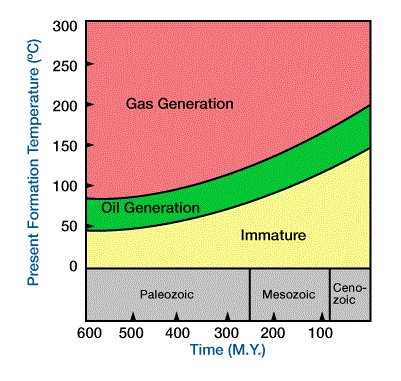Depth, Temperature and Time Effects
Petroleum generation is related to the burial depths of source rocks. The local geothermal gradient, kerogen type and burial history affect the generation depths for particular types of source rocks. Figure 1 shows average maximum and minimum generation depths.

At very shallow depths, only biogenic methane is generated during diagenesis by the action of anaerobic bacteria. At depths of 1 to 2 km, catagenesis begins. The principal zone of oil formation during the early stage of catagenesis — the oil window — begins at depths of 1 to 2 km and continues to a depth of approximately 3 km. The gas window ranges from 3 to about 4 km, and corresponds to the stage of late catagenesis during which predominantly gas forms. Below this zone, source rocks are over-mature and only methane gas is formed.
The correlation of petroleum generation with depth is primarily a function of increased temperature (Figure 2).

Major oil generation begins when source rocks are heated above 60 degrees C. These low-temperature oils, formed at relatively shallow depths, tend to be heavy and laden with non-saturated oil (NSO) compounds. Oils become lighter at greater depths and higher temperatures. Oil generation peaks at temperatures in the vicinity of 100 degrees C, beyond which oil generation declines and condensates form. The boundary between the oil and gas windows occurs at approximately 175 degrees C. Direct generation of hydrocarbons from kerogen stops at approximately 225 degrees C; methane, however, can form from the cracking of previously formed oil up to 315 degrees C.
The western Canada Basin is a good example of the relationship between maturation and depth. Shallow Upper Cretaceous sediments contain immature source rocks that yield dry gas with a high nitrogen content. At greater depths, Cretaceous and Devonian rocks produce oil and wet gas. Deeply buried Paleozoic rocks in the depocenter produce methane and hydrogen sulfide gases.
Chemical reaction rates vary as functions of both temperature and time. As seen in Figure 3, temperatures for oil formation are lowest for Paleozoic source rocks and are progressively higher for Mesozoic and Cenozoic source rocks.

This relationship between the temperature of oil formation and geologic time may be due to the phenomenon that time compensates for temperature and vice versa. For example, source rocks that have always remained cool may take more than a hundred million years to generate oil, whereas young source rocks subjected to sufficiently high temperatures might generate oil within a few million years.
The effect of temperature is exponential, while that of time is linear. Therefore, temperature generally plays a greater role than time in maturation of source rocks. For example, Paleozoic rocks that have never been heated above 50 degrees C will not generate petroleum, regardless of the passage of time. Conversely, time is insignificant in petroleum generation from young source rocks in active basins with high thermal gradients.
Wherever rapid burial occurs and geothermal gradients are high, hydrocarbon generation takes place early. Examples include the Miocene-Pliocene beds of Indonesia and California. And, while the generation of petroleum can happen over relatively short time intervals, it might not happen until long after deposition. For example, Silurian-age source rocks in eastern Algeria did not generate hydrocarbons until they were deeply buried during Mesozoic time.
 Petro Shine The Place for Oil and Gas Professionals.
Petro Shine The Place for Oil and Gas Professionals.



